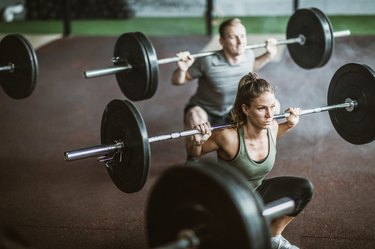
Your personal training goals and fitness level should determine the muscle group you work first, large or small. If you are new to resistance training, the order in which you perform your exercises can make a difference in the development of smaller muscles.
Tip
Work the large muscles first using multi-joint exercises, followed by the smaller muscles using single-joint exercises. Since your small muscles often act as stabilizers for the large muscles, it only makes sense to work the large muscles to fatigue first.
Video of the Day
Largest to Smallest Muscle Groups
Your largest muscle groups include your legs, buttocks, back and chest. Your gluteus maximus muscles are the largest in your body.
Video of the Day
Quadriceps muscles on the front of the thighs and hamstring muscles on the backs of the thighs are also large, powerful muscles. Large muscles in your back are the traps, or trapezius, and lats, or latissimus dorsi. Your largest chest muscle is your pectoralis major, or pecs.
Small muscles that may require special attention, depending upon your bodybuilding and fitness goals, are your forearm muscles, calves of your legs, shoulder deltoid muscles and pectoralis minor in your chest.
Order Based Upon Goals
Muscle fatigue during the later exercise sets of a workout routine results in decreased performance of the muscles worked. With this in mind, tailor the sequence of your routine to fit your overall bodybuilding or functional goals.
If you need forearm development, for instance, then exercise this muscle early in your workout sequence, before your arm muscles tire.
Read more: How Often Can I Train a Muscle to Gain Mass?
Large Muscle Groups First?
If you exercise your small muscles first, you limit your ability to overload your large muscles, due to fatigue of the smaller, supportive muscles. Because working a muscle to fatigue is important in building mass, working your smaller shoulder muscles first can hinder your progress in building your chest muscles.
When building mass is your goal, you can exercise your small muscles after your large-muscle workout. Dr. Len Kravitz writing for the University of New Mexico recommends that trainers or individuals figure out the best muscle group combinations to workout together.
Schedule the workout around performing multi-joint exercises first — squats, push-ups, lunges — followed by single-joint —calf raise, knee extension, biceps curl — to prevent muscle exhaustion.
Read more: The Best Exercises for Every Major Muscle
Exercise Wisely by Following Protocol
Regardless of how you order your workout routine, begin with five to 10 minutes of warm-up exercises, such as walking, cycling, calisthenics or low-weight repetitions of the exercise you plan to perform.
ACE Fitness recommends going through the motion you are about to perform for the upper body muscle groups, only without the weights. For the lower body, if you were going to perform some lunges, warm up by lifting your knee to your chest and then extending it back. At the end of your routine, cool down with five to 10 minutes of stretching.
Stretching while your muscles are warmed up from exercise can increase your flexibility and prevent muscle soreness. If you are new to regimented exercise routines, consult with your medical provider before you begin an exercise program.